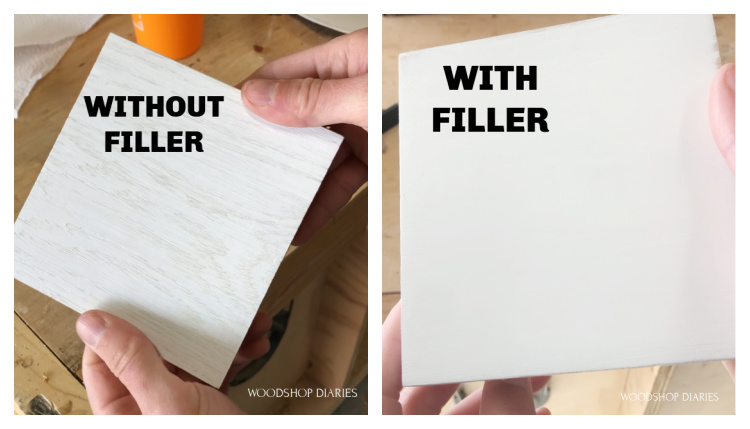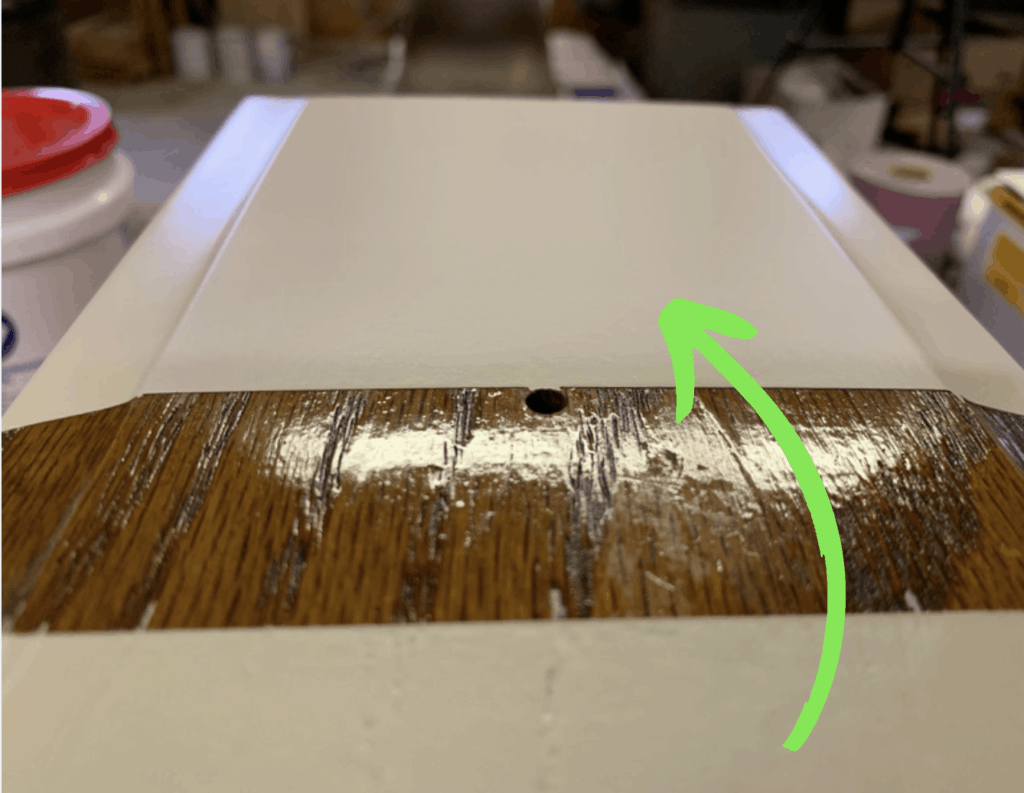Understanding Wood Grain Fillers

Oak cabinets, known for their timeless elegance and durability, often possess a unique characteristic: open grain. This feature, while contributing to the wood’s beauty, can present challenges when achieving a smooth, even finish. Enter wood grain fillers, a crucial tool for transforming the surface of oak cabinets into a canvas ready for stunning finishes.
Types of Wood Grain Fillers
Wood grain fillers come in various forms, each with distinct properties suited for different applications.
- Paste Fillers: These fillers, typically oil-based, offer a thick consistency that readily fills open grain. Their paste-like texture allows for easy application and removal of excess filler, making them ideal for beginners. Paste fillers often contain pigments, enabling them to match the wood’s color. However, they require sanding after drying, and may not be suitable for intricate details due to their thickness.
- Liquid Fillers: Liquid fillers, often water-based or solvent-based, provide a thinner consistency, making them easier to apply to intricate details. They penetrate the wood grain more effectively than paste fillers, offering a smoother finish. Liquid fillers are available in various finishes, including clear, tinted, and pigmented. However, they require careful application to avoid overfilling, and may not be as effective in filling deep grain.
- Epoxy Fillers: Epoxy fillers, a two-part system, offer exceptional durability and adhesion. They are ideal for filling deep cracks and voids, and are highly resistant to moisture and chemicals. Epoxy fillers are often used in high-traffic areas, such as kitchen cabinets. However, they require precise mixing and application, and can be challenging to sand due to their hardness.
Choosing the Right Filler
Selecting the appropriate wood grain filler is crucial for achieving the desired finish. Factors to consider include:
- Grain Depth: For deep grain, paste or epoxy fillers are recommended, while liquid fillers are suitable for shallow grain.
- Desired Finish: If a smooth, even finish is desired, liquid fillers are often preferred. For a more rustic look, paste fillers can be used to create a subtle texture.
- Application Area: For intricate details, liquid fillers are more suitable due to their thinner consistency. For large areas, paste fillers can be applied quickly and easily.
- Environmental Considerations: Water-based fillers are generally safer for the environment than solvent-based fillers.
Application Process and Techniques: Wood Grain Filler For Oak Cabinets

Applying wood grain filler to oak cabinets is a meticulous process that requires precision and patience. This process involves preparing the surface, applying the filler, and allowing it to cure properly. The key is to ensure a smooth and even application, resulting in a beautiful and durable finish.
Surface Preparation
Proper preparation is crucial for a successful application. This involves sanding, cleaning, and masking the surface to ensure the filler adheres properly.
- Sand the surface of the oak cabinets with progressively finer grit sandpaper, starting with 120 grit and finishing with 220 grit. This process creates a smooth surface and removes any imperfections.
- Thoroughly clean the surface with a tack cloth to remove dust and debris. This ensures the filler adheres properly to the wood.
- Mask off areas that you don’t want to be filled with the grain filler using painter’s tape. This protects the surrounding areas from accidental spills or overspray.
Applying Wood Grain Filler
The application of the wood grain filler is a crucial step in the process. The key is to apply it evenly and in a thin layer.
- Apply the wood grain filler using a putty knife, a small brush, or a rubber spreader. Apply it in thin, even coats, working it into the grain of the wood.
- Avoid applying the filler too thickly. Thick coats can lead to uneven drying and cracking.
- Wipe off any excess filler with a clean cloth, working with the grain of the wood. This ensures a smooth and even finish.
Drying Time and Curing
Allow the filler to dry completely according to the manufacturer’s instructions. This drying time can vary depending on the type of filler used and the environmental conditions. Once the filler is dry, you can sand it smooth and apply a topcoat.
- Allow the filler to dry completely before sanding or applying a topcoat. This ensures the filler is properly cured and prevents it from being disturbed.
- Sand the filler with fine-grit sandpaper (220 grit or finer) to create a smooth surface.
- Apply a topcoat, such as polyurethane or lacquer, to protect the filler and enhance the appearance of the cabinets.
Finishing Touches and Maintenance

The wood grain filler acts as a canvas, ready to be adorned with the final touches of your design vision. After the filler has dried and been sanded smooth, the true character of your oak cabinets begins to emerge. This is the stage where you can choose to highlight the natural beauty of the wood or create a completely new aesthetic.
Finishing Options
The final finish you choose will determine the look and feel of your cabinets, as well as their durability and ease of maintenance. Here are some popular options:
- Staining: Staining allows you to enhance the natural grain pattern and color of the wood. It can create a variety of shades, from warm browns to rich reds. Stain is applied with a brush or cloth and allowed to penetrate the wood’s surface. After staining, a sealant is typically applied to protect the finish. Staining is a great choice for those who want to highlight the wood’s natural beauty while adding a touch of color.
- Painting: Painting offers the most flexibility in terms of color and style. You can choose from a wide range of paints, including gloss, satin, and matte finishes. Painting can completely transform the look of your cabinets, creating a modern, sleek, or rustic aesthetic. It is a good choice for those who want to cover up any imperfections in the wood or create a bold, dramatic look.
- Varnishing: Varnishing provides a protective coating that enhances the natural beauty of the wood while protecting it from scratches, moisture, and stains. Varnishes are available in various sheens, from high gloss to matte. They are typically applied in multiple thin coats to ensure a smooth, even finish. Varnishing is an excellent choice for high-traffic areas where durability is essential.
Achieving a Professional Finish
To achieve a professional-looking finish, follow these tips:
- Prepare the surface: Before applying any finish, ensure the surface is clean, dry, and free of dust or debris. Lightly sand the filled surface to create a smooth, even base for the finish.
- Apply thin, even coats: Whether you are staining, painting, or varnishing, apply the finish in thin, even coats. Allow each coat to dry completely before applying the next. Too much finish in one coat can lead to drips and uneven application.
- Use a high-quality brush or sprayer: The quality of your tools can make a significant difference in the final finish. Invest in a good quality brush or sprayer that is designed for the specific type of finish you are using.
- Sand between coats: For stains and varnishes, lightly sand between coats to create a smooth, even finish. Use a fine-grit sandpaper and be careful not to remove too much of the previous coat.
- Apply a final coat of sealant: After applying the final coat of finish, apply a sealant to protect the surface from wear and tear. Sealants can be clear or tinted, depending on your preference.
Maintenance and Care, Wood grain filler for oak cabinets
Proper maintenance is essential for preserving the beauty and longevity of your oak cabinets with wood grain filler. Here are some tips:
- Clean regularly: Clean your cabinets with a damp cloth and mild soap. Avoid using harsh chemicals or abrasive cleaners that can damage the finish. For stubborn stains, use a gentle cleaner specifically designed for wood surfaces.
- Protect from moisture: Oak is susceptible to moisture damage, so avoid exposing your cabinets to excessive humidity or water. Wipe up spills immediately and ensure the area is dry.
- Apply a fresh coat of finish: Over time, the finish on your cabinets may wear down. To protect your cabinets and maintain their beauty, apply a fresh coat of finish every few years. This will help to prevent damage and keep them looking their best.
Repairing Damage
Even with proper care, your cabinets may eventually experience some damage. Here are some tips for repairing common imperfections:
- Scratches: For minor scratches, use a touch-up pen or marker that matches the finish color. For deeper scratches, sand the area lightly with fine-grit sandpaper and apply a thin coat of finish.
- Dings and dents: For small dings and dents, use a wood filler that matches the color of your cabinets. Apply the filler to the damaged area, let it dry completely, and then sand it smooth. Apply a thin coat of finish to blend the repair.
- Water damage: If your cabinets have been exposed to water, dry the area thoroughly and apply a wood conditioner to restore the moisture balance. If the damage is severe, you may need to consult a professional woodworker for repair.
Wood grain filler for oak cabinets – So, you’re thinking about giving your oak cabinets a makeover? Wood grain filler is a game-changer, especially if you want that smooth, flawless finish. It’s like a magic potion that fills in those pesky imperfections, and it can even be a good base for a fresh coat of paint.
Speaking of fresh, how about a duck egg blue bedroom for a calming vibe? Anyway, back to those cabinets – once the filler dries, you’re ready for the next step, which could be a bold color or a natural stain.
Just remember, the key is to choose a filler that’s compatible with your chosen finish.
Giving your oak cabinets a flawless finish? Wood grain filler is your bestie! It’s like giving your space a little makeover, just like you’d want to do with a small bedroom with ensuite layout. You want that sleek, polished look, right?
Wood grain filler helps achieve that, giving your cabinets a smooth, even surface that’s ready for the final touch.
